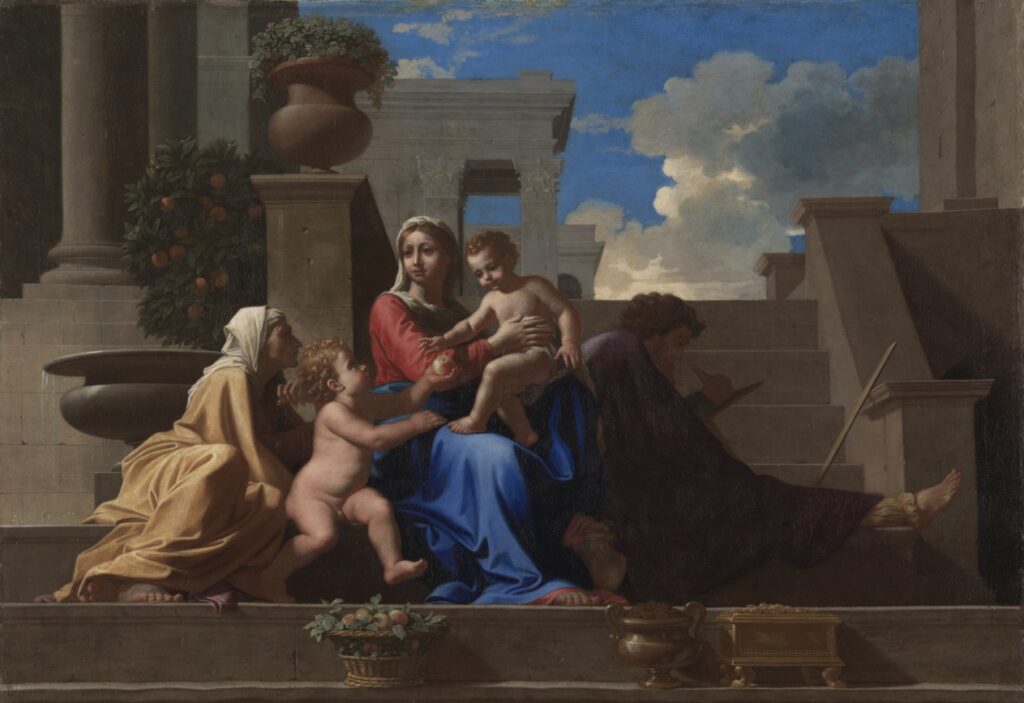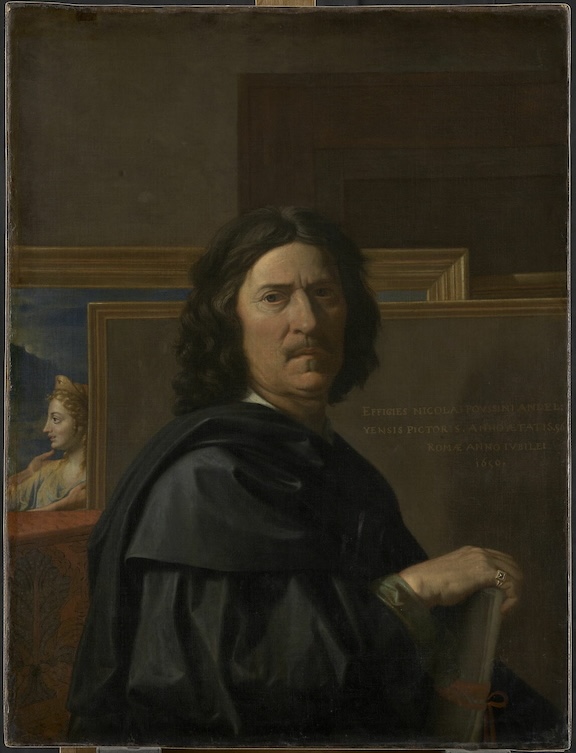Nicholas Poussin (1594-1665) used to say that a painting yields its meaning only after long and thoughtful looking. This is certainly true of Poussin’s own art. The present author has been attending to Poussin’s depiction of the Holy Family on the Steps (of the Temple) – now in the Cleveland Museum of Art – for more than half a century, and is still discovering fresh riches within it.
The composition breathes an atmosphere of calm solemnity, with its impressive architectonic structure – not just the architecture depicted, but the stable, proportioned ordering of lines, shapes, and colors throughout the canvas.
The figures form a pyramid culminating in the noble visage of the Blessed Virgin Mary, while at the center of the whole painting is her Divine Son. At the base of the compositional pyramid, we find a basket of apples (likely brought by Saint Elizabeth and her son John) and, a little to the side, two vessels of mysterious contents – perhaps the gold, frankincense, and myrrh presented by the Magi.
The bright profile figures of Elizabeth and John lead our eye to the Ever-Virgin Mary and to Christ. The Lord reaches to accept an apple proffered by His cousin, as He has come into the world to take upon Himself the weight of suffering for our sin – the fruit of Adam’s fall.
Our Lady is pictorially likened to the Temple through her majestic, upright posture and the rhyming of her proportions with those of the plinth and vase of flowers beside her. “Wisdom hath built herself a house, she hath hewn her out seven pillars.” (Proverbs 9:1) The steps of the Temple, and the steps in Poussin’s painting, represent ascent to the holy place where God dwells.
But the Old Testament Temple could only symbolize what, in the fullness of time, Mary of Nazareth became: the house of God and the stairway of heaven. (See Genesis 28:17) Christ is depicted as if striding down from the glorious heaven and treating His mother’s celestial-blue-robed thigh as a step.
In the whole picture, the only blue patches are the sky and Our Lady’s robe. To underscore its significance, Poussin painted a rectangular aperture of blue sky surmounting Christ’s head, vertically aligned with His mother’s blue robe. Through the Holy Virgin Mary, the Lord descends to save us, and we in turn ascend, in the series of bright forms in the painting, from lower left, through Mary, to the glory at upper right.
The apex of the compositional pyramid is shifted to the left. This design allows the right half of the painting to be devoted to the shadowed figure of Saint Joseph, the designer and builder at work with his dividers, with his measuring rod propped on the staircase.

If Mary is identified with the Temple through her form, Joseph blends with it through his tone. His presentation as an architect on the Temple steps puts us in mind of Solomon, the first Temple’s builder, and heir of David’s royalty. Indeed, Joseph wears purple.
Moreover, the dividers in his hand recall medieval images of God the creator of the cosmos. In the beginning, God made the earth as a temple to house His image, man. The Jewish Temple was a promise of a restored paradise – hence the prominent orange tree and the fountain. Joseph, protecting Mary – the spouse of the Holy Spirit – and standing in loco parentis to Christ, represents God the Father, the hidden God. “Verily thou art a hidden God, the God of Israel the savior.” (Isaiah 45:15) The Deus absconditus is veiled in shadow.
While alluding to the hidden God, he yet remains the man Joseph. As such, his being in shadow may indicate his humility, his avoidance of the spotlight. Or his silence. Or his being “in the dark” in some respect, as a man who walks by faith, not by sight. It likely stands for all these things, and more.
Note that his foot is illumined. Clearly, Poussin needed a bright spot there to balance the light in the left half of the canvas. But artists commonly find that, in the inspired development of a work of art, a formal requisite becomes the occasion for an unanticipated breakthrough of meaning.
At this point the meaning blazes forth for us, as it must have for Poussin as he was painting. Joseph is the just man who trusts God’s law to direct his feet, to light up the next step for him to take:
Thy word is a lamp unto my feet, and a light unto my paths.
I have sworn and am determined to keep the judgments of thy justice. (Psalm 118:105-106)
David used this alphabetical psalm to teach his son Solomon (whose name means “man of peace”) both the Hebrew letters and the alphabet of holy living. The psalm’s full meaning is revealed when David’s Lord, the Prince of Peace, accepts His Passion. Christ is the righteous man whose life is in God’s hands and who, therefore, cannot be held by death:
I have been humbled, O Lord, exceedingly: quicken thou me according to thy word. . . .
Sinners have laid a snare for me: but I have not erred from thy precepts. . . .
Thou art my helper and my protector: and in thy word I have greatly hoped. . . .
I have known from the beginning concerning thy testimonies: that thou hast founded them for ever.
See my humiliation and deliver me: for I have not forgotten thy law.
Judge my judgment and redeem me: quicken thou me for thy word’s sake. (Psalm 119:107-153)
The two sides of the painting, the bright side and the shadowed side, thus have everything to do with each other. Joseph imitates his foster-son and makes his own the words of his royal ancestor, and so the luminous cloud atop the steps crowns his head with glory.
When Poussin was asked what was the secret of his excellence, he replied “I have neglected nothing.” We do well to follow his example.
















